On the Genesis of the South China Sea Mesoscale Eddies
Abstract
1. Introduction
2. Methods and Materials
2.1. Methodology
2.1.1. Multiscale Window Transform
2.1.2. Canonical Transfer Theory
2.1.3. MWT Setup
2.2. Data
3. Results
3.1. Mesoscale EKE Distributions in the SCS
3.2. Dynamics Underlying the Regional Mesoscale EKE
3.2.1. Inter-Scale Canonical Transfer
3.2.2. Intra-Scale Energy Transport and Buoyancy Conversion
3.2.3. Wind Work
3.3. Energy Diagram
4. Conclusions
Author Contributions
Funding
Institutional Review Board Statement
Informed Consent Statement
Data Availability Statement
Acknowledgments
Conflicts of Interest
References
- Fang, G.; Wang, G.; Fang, Y.; Fang, W. A Review on the South China Sea Western Boundary Current. Acta Oceanol. Sin. 2012, 31, 1–10. [Google Scholar] [CrossRef]
- Nan, F.; Xue, H.; Yu, F. Kuroshio Intrusion into the South China Sea: A Review. Prog. Oceanogr. 2015, 137, 314–333. [Google Scholar] [CrossRef]
- Xiu, P.; Chai, F.; Shi, L.; Xue, H.; Chao, Y. A Census of Eddy Activities in the South China Sea during 1993–2007. J. Geophys. Res. 2010, 115, C03012. [Google Scholar] [CrossRef]
- Ding, R.; Xuan, J.; Zhang, T.; Zhou, L.; Zhou, F.; Meng, Q.; Kang, I.-S. Eddy-Induced Heat Transport in the South China Sea. J. Phys. Oceanogr. 2021, 51, 2329–2349. [Google Scholar] [CrossRef]
- Chen, G.; Hou, Y.; Chu, X. Mesoscale Eddies in the South China Sea: Mean Properties, Spatiotemporal Variability, and Impact on Thermohaline Structure. J. Geophys. Res. Oceans 2011, 116. [Google Scholar] [CrossRef]
- Cheng, X.; Qi, Y. Variations of Eddy Kinetic Energy in the South China Sea. J. Oceanogr. 2010, 66, 85–94. [Google Scholar] [CrossRef]
- Chen, G.; Hou, Y.; Chu, X.; Qi, P.; Hu, P. The Variability of Eddy Kinetic Energy in the South China Sea Deduced from Satellite Altimeter Data. Chin. J. Oceanol. Limnol. 2009, 27, 943–954. [Google Scholar] [CrossRef]
- Gill, A.E.; Green, J.S.A.; Simmons, A.J. Energy Partition in the Large-Scale Ocean Circulation and the Production of Mid-Ocean Eddies. Deep Sea Res. Oceanogr. Abstr. 1974, 21, 499–528. [Google Scholar] [CrossRef]
- Ferrari, R.; Wunsch, C. Ocean Circulation Kinetic Energy: Reservoirs, Sources, and Sinks. Annu. Rev. Fluid Mech. 2009, 41, 253–282. [Google Scholar] [CrossRef]
- von Storch, J.-S.; Eden, C.; Fast, I.; Haak, H.; Hernández-Deckers, D.; Maier-Reimer, E.; Marotzke, J.; Stammer, D. An Estimate of the Lorenz Energy Cycle for the World Ocean Based on the STORM/NCEP Simulation. J. Phys. Oceanogr. 2012, 42, 2185–2205. [Google Scholar] [CrossRef]
- Yang, H.; Wu, L.; Liu, H.; Yu, Y. Eddy Energy Sources and Sinks in the South China Sea. J. Geophys. Res. Ocean 2013, 118, 4716–4726. [Google Scholar] [CrossRef]
- Chen, G.; Gan, J.; Xie, Q.; Chu, X.; Wang, D.; Hou, Y. Eddy Heat and Salt Transports in the South China Sea and Their Seasonal Modulations. J. Geophys. Res. 2012, 117. [Google Scholar] [CrossRef]
- Wang, H.; Wang, D.; Liu, G.; Wu, H.; Li, M. Seasonal Variation of Eddy Kinetic Energy in the South China Sea. Acta Oceanol. Sin. 2012, 31, 1–15. [Google Scholar] [CrossRef]
- Yang, Y.; Liang, X.S. On the Seasonal Eddy Variability in the Kuroshio Extension. J. Phys. Oceanogr. 2018, 48, 1675–1689. [Google Scholar] [CrossRef]
- Kang, D.; Curchitser, E.N.; Rosati, A. Seasonal Variability of the Gulf Stream Kinetic Energy. J. Phys. Oceanogr. 2016, 46, 160224111526006. [Google Scholar] [CrossRef]
- Jouanno, J.; Sheinbaum, J.; Barnier, B.; Molines, J.M.; Candela, J. Seasonal and Interannual Modulation of the Eddy Kinetic Energy in the Caribbean Sea. J. Phys. Oceanogr. 2012, 42, 2041–2055. [Google Scholar] [CrossRef]
- Scott, R.B.; Wang, F. Direct Evidence of an Oceanic Inverse Kinetic Energy Cascade from Satellite Altimetry. J. Phys. Oceanogr. 2005, 35, 1650–1666. [Google Scholar] [CrossRef]
- Scott, R.B.; Arbic, B.K. Spectral Energy Fluxes in Geostrophic Turbulence: Implications for Ocean Energetics. J. Phys. Oceanogr. 2007, 37, 673–688. [Google Scholar] [CrossRef]
- Sérazin, G.; Penduff, T.; Barnier, B.; Molines, J.-M.; Arbic, B.K.; Müller, M.; Terray, L. Inverse Cascades of Kinetic Energy as a Source of Intrinsic Variability: A Global OGCM Study. J. Phys. Oceanogr. 2018, 48, 1385–1408. [Google Scholar] [CrossRef]
- Yang, Y.; Liang, X.S. New Perspectives on the Generation and Maintenance of the Kuroshio Large Meander. J. Phys. Oceanogr. 2019, 49, 2095–2113. [Google Scholar] [CrossRef]
- Frankignoul, C.; Müller, P. Quasi-Geostrophic Response of an Infinite β-Plane Ocean to Stochastic Forcing by the Atmosphere. J. Phys. Oceanog. 1979, 9, 104–127. [Google Scholar] [CrossRef][Green Version]
- Müller, P.; Frankignoul, C. Direct Atmospheric Forcing of Geostrophic Eddies. J. Phys. Oceanogr. 1981, 11, 287–308. [Google Scholar] [CrossRef][Green Version]
- Garnier, V.; Schopp, R. Wind Influence on the Mesoscale Activity along the Gulf Stream and the North Atlantic Currents. J. Geophys. Res. 1999, 104, 18087–18110. [Google Scholar] [CrossRef]
- Stammer, D.; Böning, C.; Dieterich, C. The Role of Variable Wind Forcing in Generating Eddy Energy in the North Atlantic. Prog. Oceanogr. 2001, 48, 289–311. [Google Scholar] [CrossRef][Green Version]
- Brachet, S. Mesoscale Variability from a High-Resolution Model and from Altimeter Data in the North Atlantic Ocean. J. Geophys. Res. 2004, 109, C12025. [Google Scholar] [CrossRef]
- Xu, C.; Zhai, X.; Shang, X.-D. Work Done by Atmospheric Winds on Mesoscale Ocean Eddies: Wind work on ocean eddies. Geophys. Res. Lett. 2016, 43, 12174–12180. [Google Scholar] [CrossRef]
- Renault, L.; McWilliams, J.C.; Masson, S. Satellite Observations of Imprint of Oceanic Current on Wind Stress by Air-Sea Coupling. Sci Rep. 2017, 7, 17747. [Google Scholar] [CrossRef]
- Zhao, Y.; Yang, Y.; Liang, X.S.; Zhang, Y. Different Mechanisms for the Seasonal Variations of the Mesoscale Eddy Energy in the South China Sea. Deep Sea Res. Part I Oceanogr. Res. Pap. 2021, 179, 103677. [Google Scholar] [CrossRef]
- Liang, X.S.; Anderson, D.G.M. Multiscale Window Transform. Multiscale Model. Simul. 2007, 6, 437–467. [Google Scholar] [CrossRef]
- Liang, X.S. Canonical Transfer and Multiscale Energetics for Primitive and Quasigeostrophic Atmospheres. J. Atmos. Sci. 2016, 73, 4439–4468. [Google Scholar] [CrossRef]
- Wunsch, C. The Work Done by the Wind on the Oceanic General Circulation. J. Phys. Oceanogr. 1998, 28, 2332–2340. [Google Scholar] [CrossRef]
- Pedlosky, J. Geophysical Fluid Dynamics; Springer: Berlin/Heidelberg, Germany, 1979; p. 624. [Google Scholar]
- Liang, X.S.; Robinson, A.R. Localized Multiscale Energy and Vorticity Analysis. Dyn. Atmos. Oceans 2005, 38, 195–230. [Google Scholar] [CrossRef]
- Zhang, M.; von Storch, H.; Chen, X.; Wang, D.; Li, D. Temporal and Spatial Statistics of Travelling Eddy Variability in the South China Sea. Ocean Dyn. 2019, 69, 879–898. [Google Scholar] [CrossRef]
- Zhao, Y.B.; Liang, X.S.; Gan, J. Nonlinear Multiscale Interactions and Internal Dynamics Underlying a Typical Eddy-Shedding Event at Luzon Strait: Luzon Eddy-Shedding Dynamics. J. Geophys. Res. Oceans 2016, 121, 8208–8229. [Google Scholar] [CrossRef]
- Zhang, Z.; Zhao, W.; Qiu, B.; Tian, J. Anticyclonic Eddy Sheddings from Kuroshio Loop and the Accompanying Cyclonic Eddy in the Northeastern South China Sea. J. Phys. Oceanogr. 2017, 47, 1243–1259. [Google Scholar] [CrossRef]
- Quan, Q.; Cai, Z.; Jin, G.; Liu, Z. Topographic Rossby Waves in the Abyssal South China Sea. J. Phys. Oceanogr. 2021, 51, 1795–1812. [Google Scholar] [CrossRef]
- Li, Y.; Han, W.; Wilkin, J.L.; Zhang, W.G.; Arango, H.; Zavala-Garay, J.; Levin, J.; Castruccio, F.S. Interannual Variability of the Surface Summertime Eastward Jet in the South China Sea. J. Geophys. Res. Oceans 2014, 119, 7205–7228. [Google Scholar] [CrossRef]
- Grooms, I.; Nadeau, L.-P.; Smith, S. Mesoscale Eddy Energy Locality in an Idealized Ocean Model. J. Phys. Oceanogr. 2013, 43, 1911–1923. [Google Scholar] [CrossRef]
- Quan, Q.; Liu, Z.; Sun, S.; Cai, Z.; Yang, Y.; Jin, G.; Li, Z.; Liang, X.S. Influence of the Kuroshio Intrusion on Deep Flow Intraseasonal Variability in the Northern South China Sea. J. Geophys. Res. Oceans 2021, 126, e2021JC017429. [Google Scholar] [CrossRef]
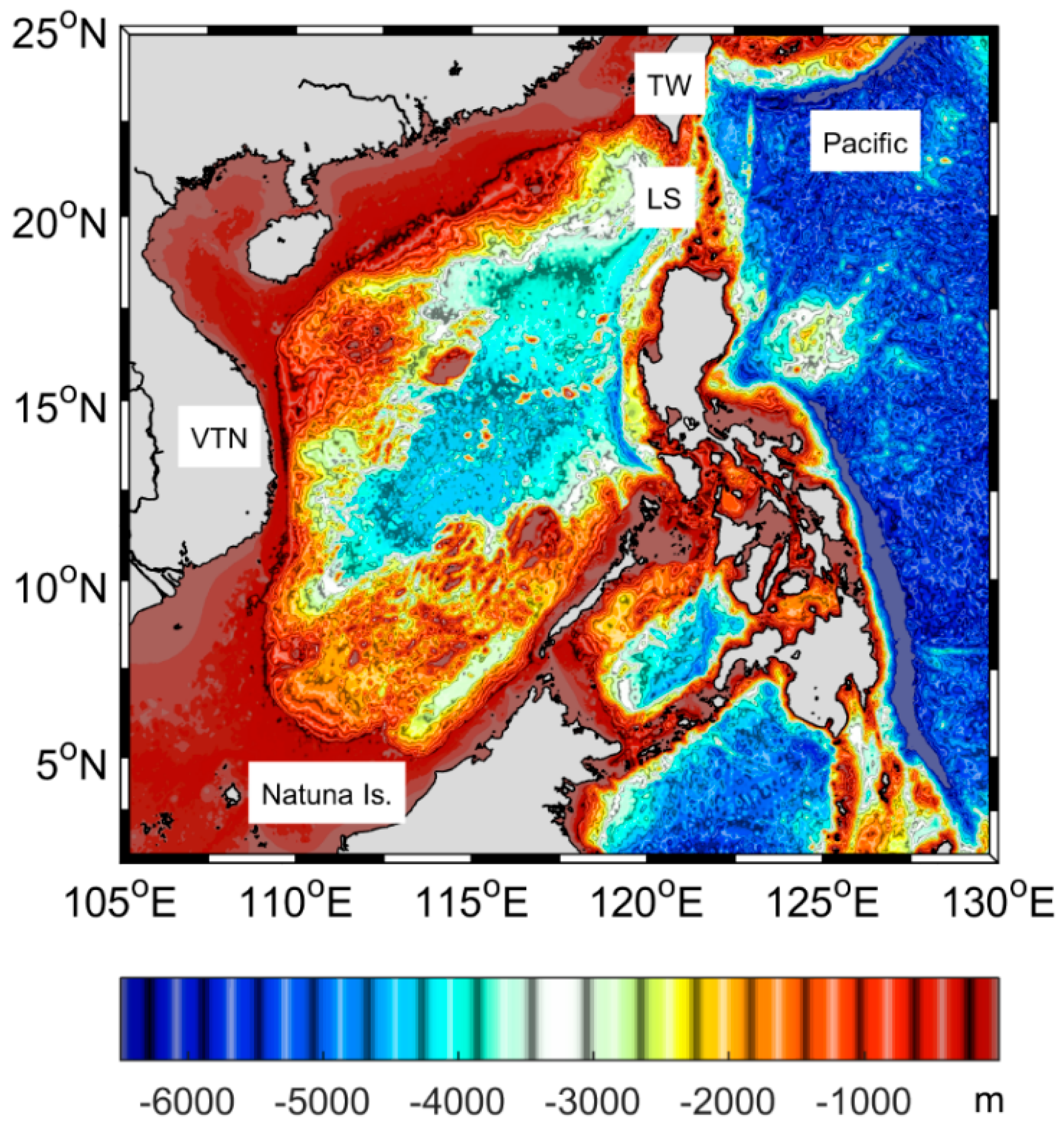
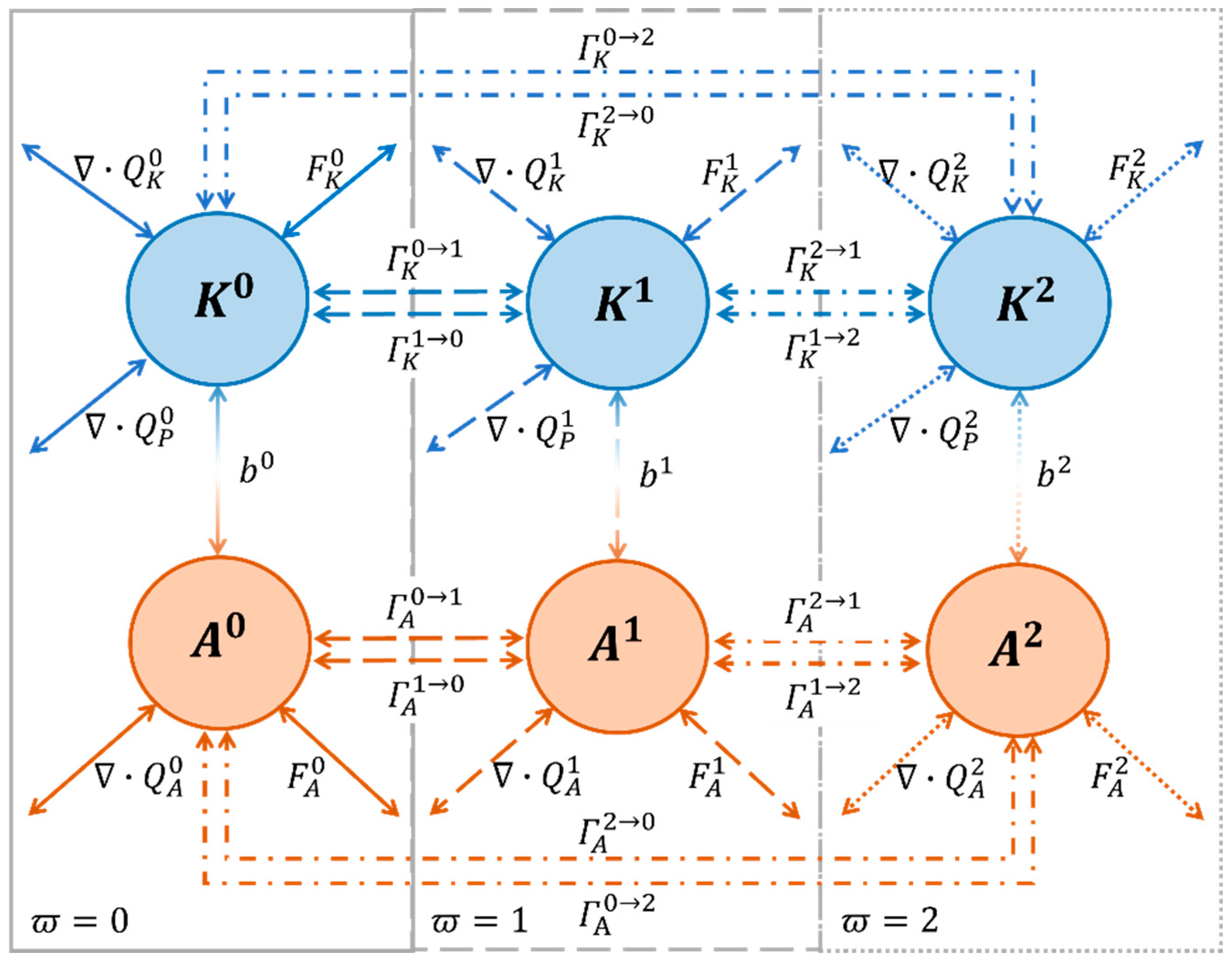
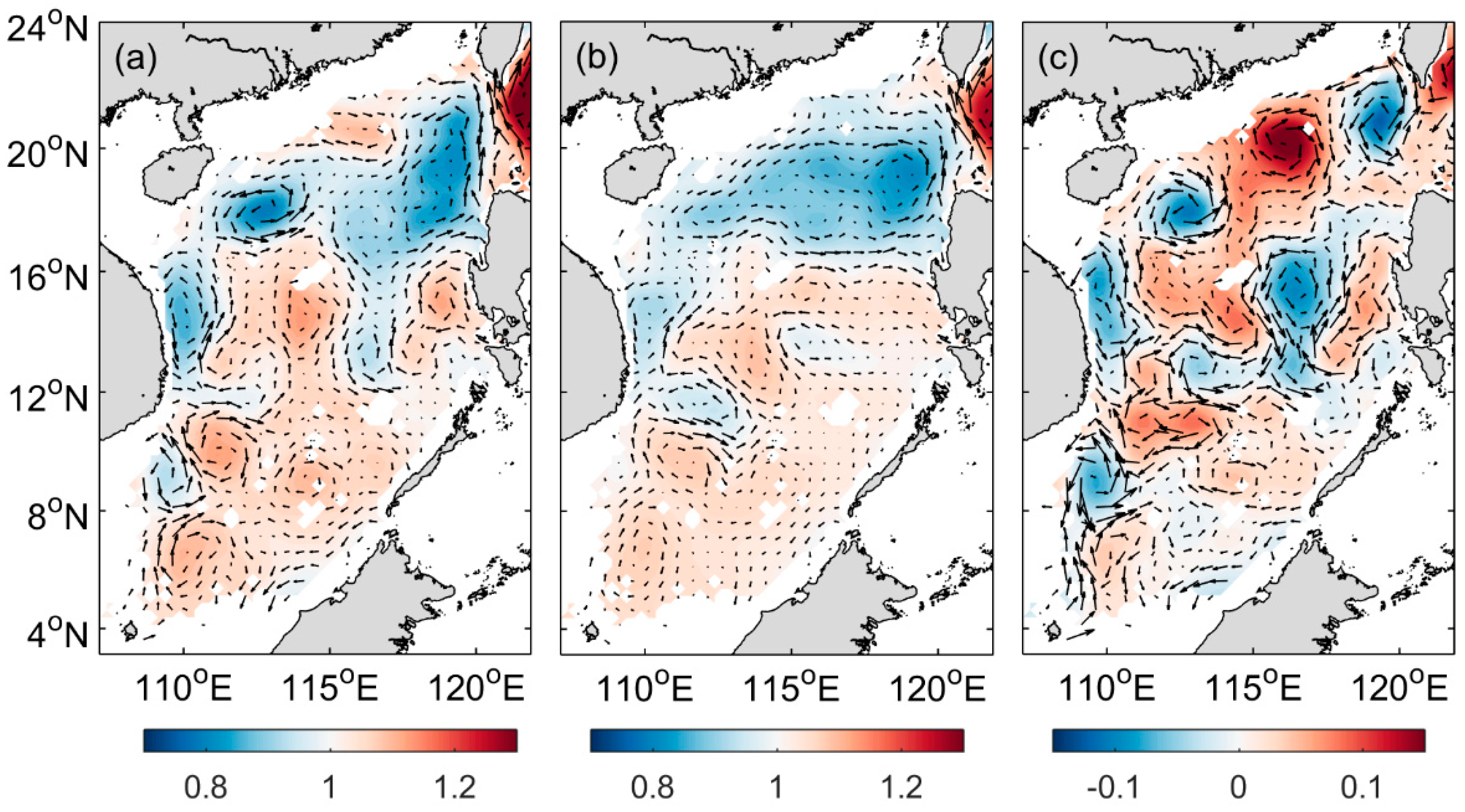
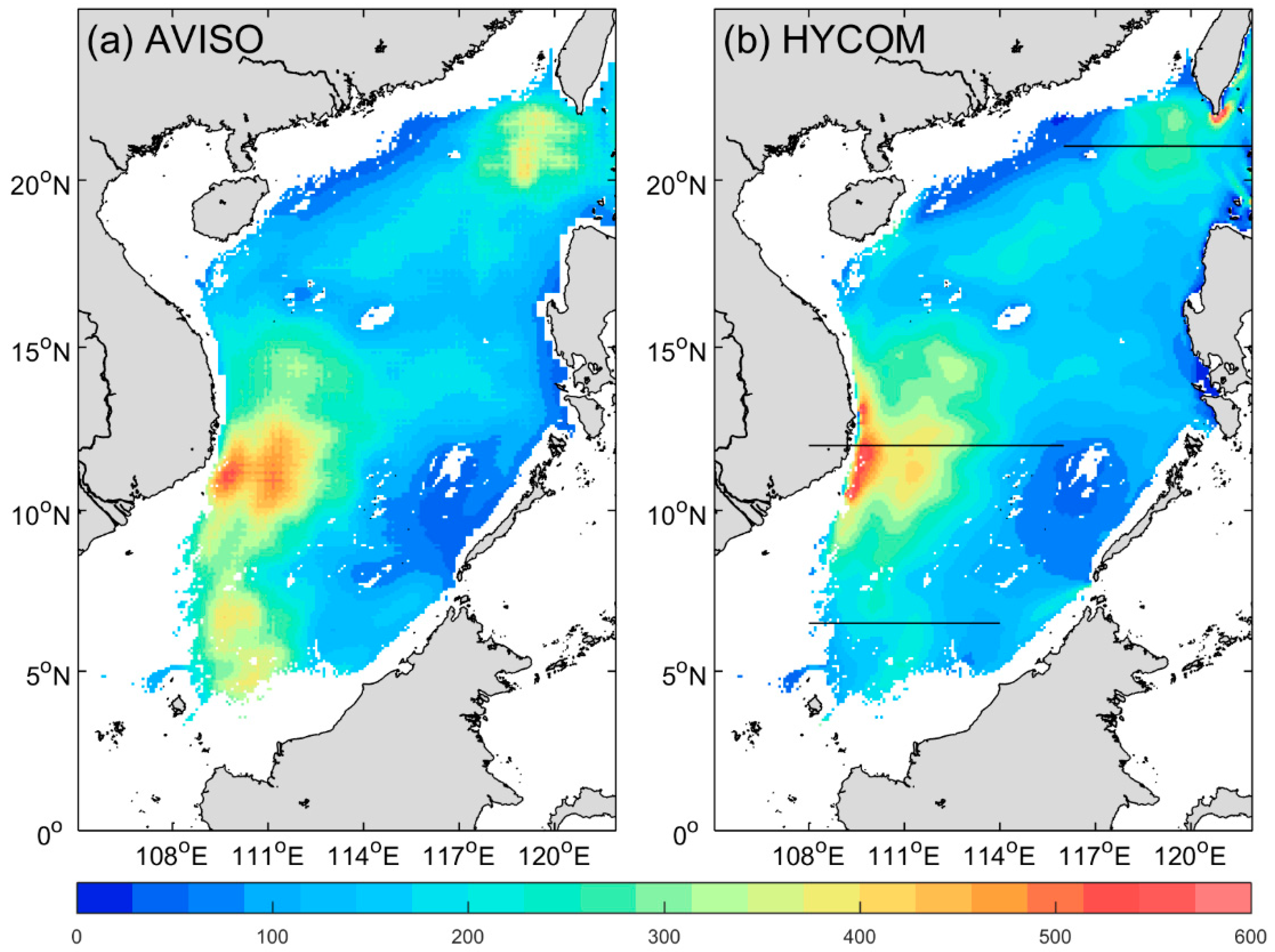
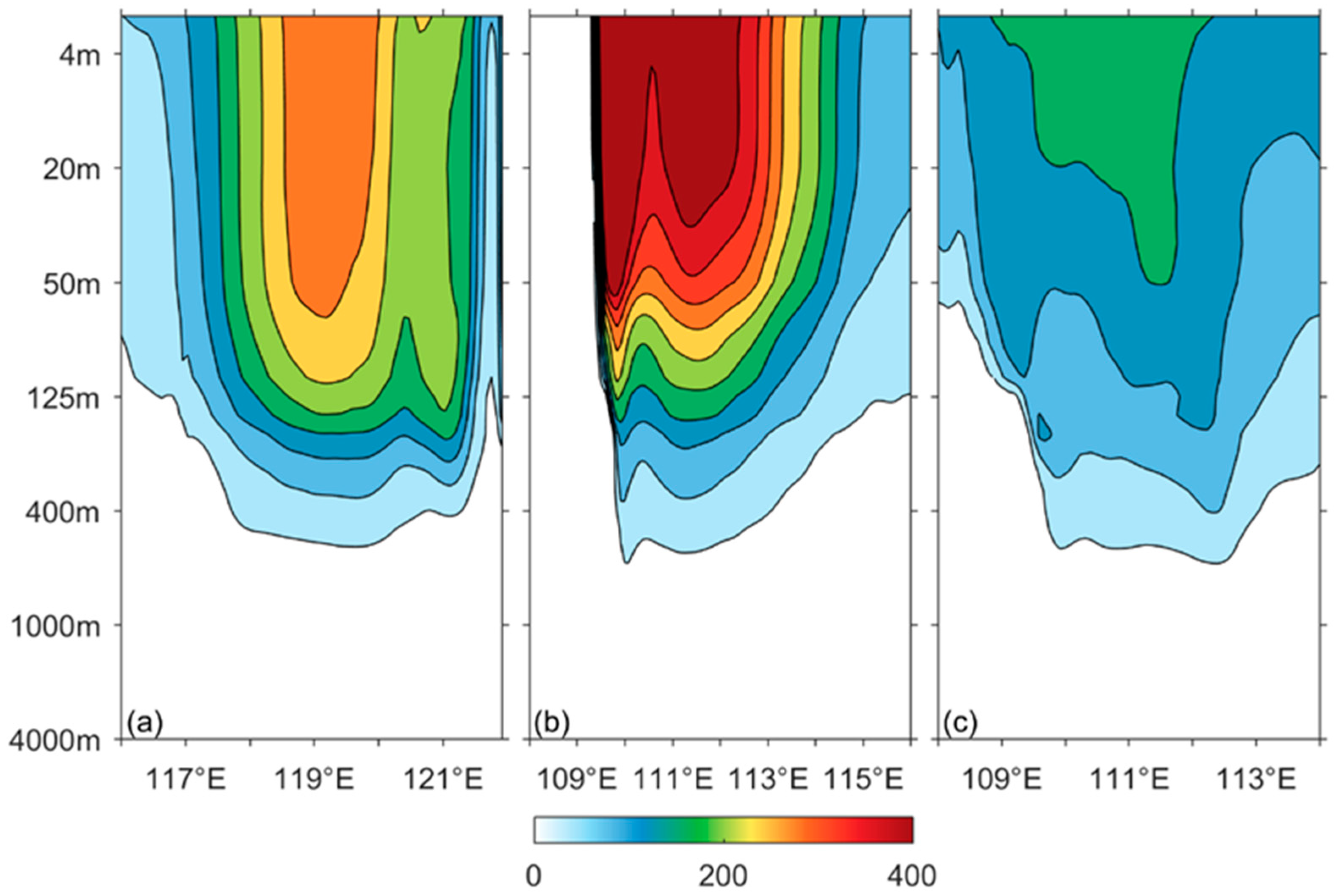
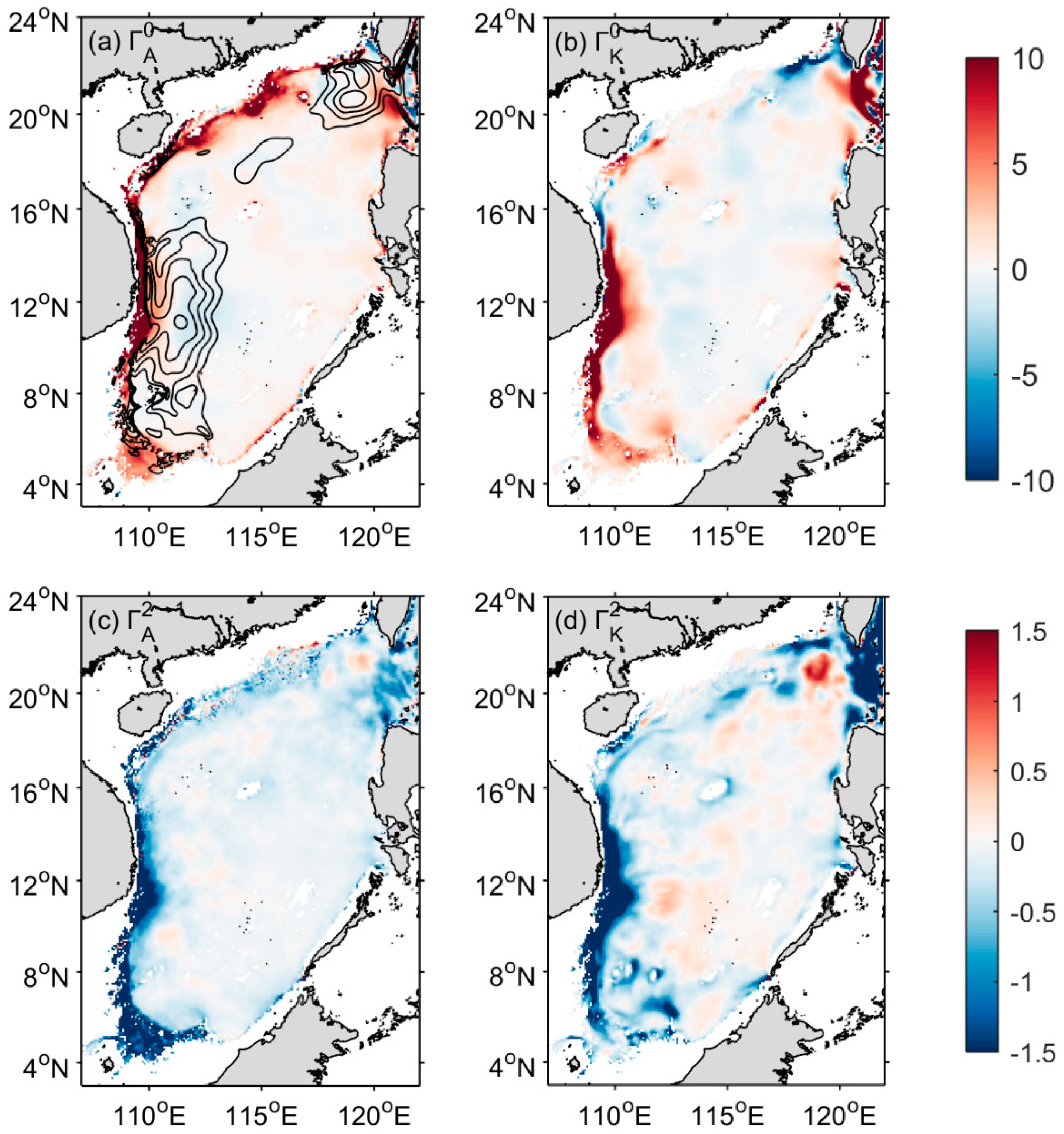
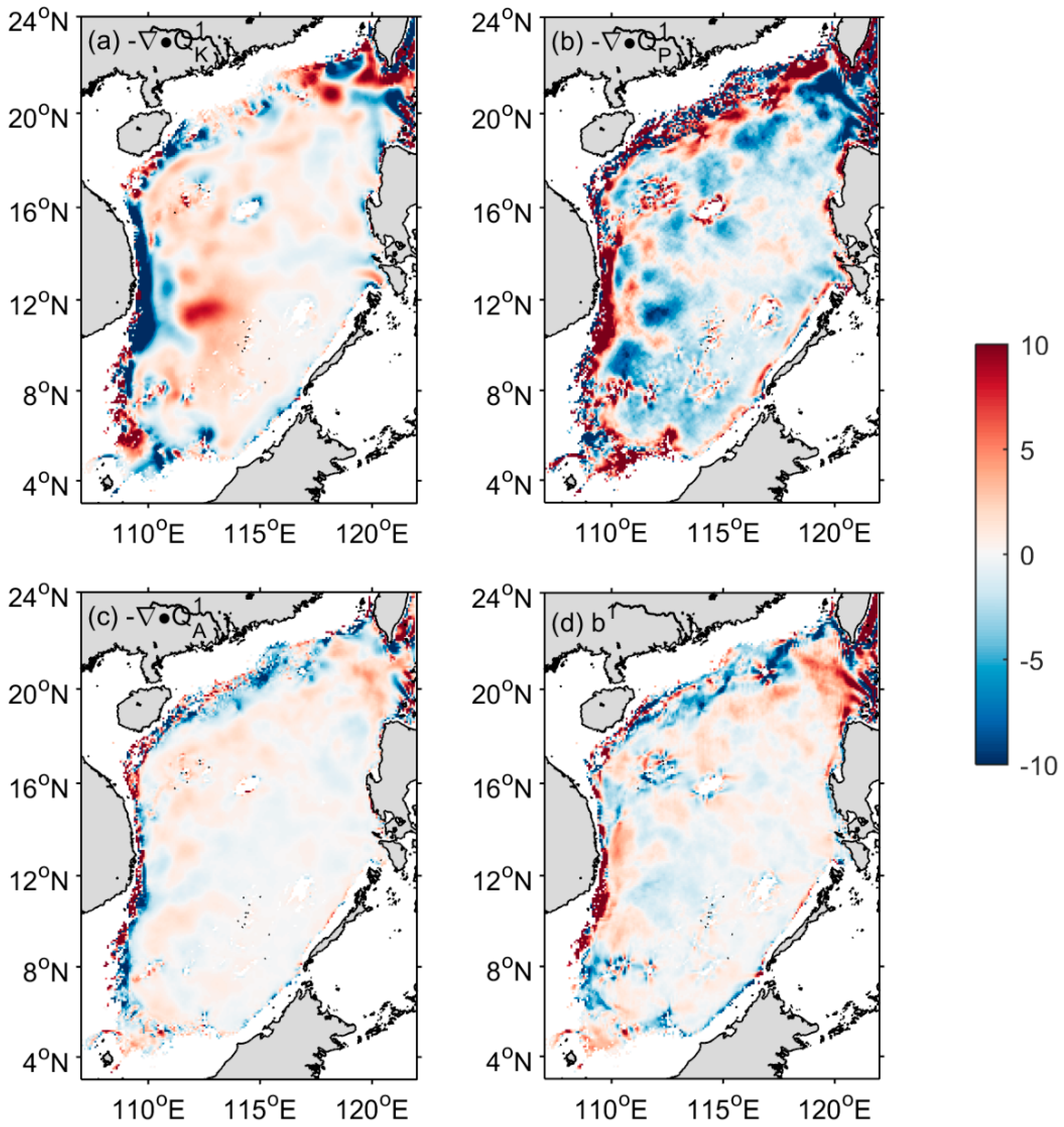
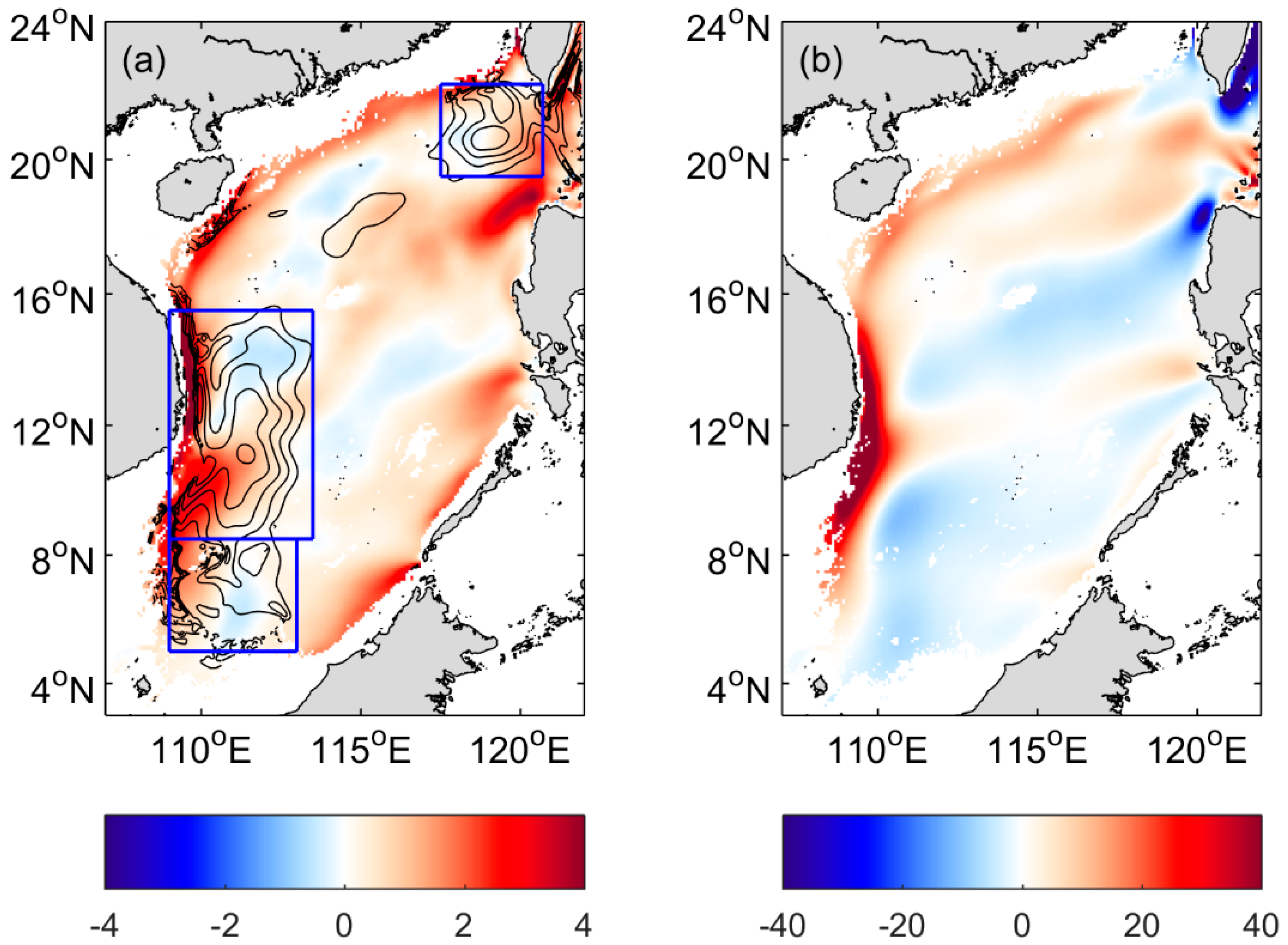
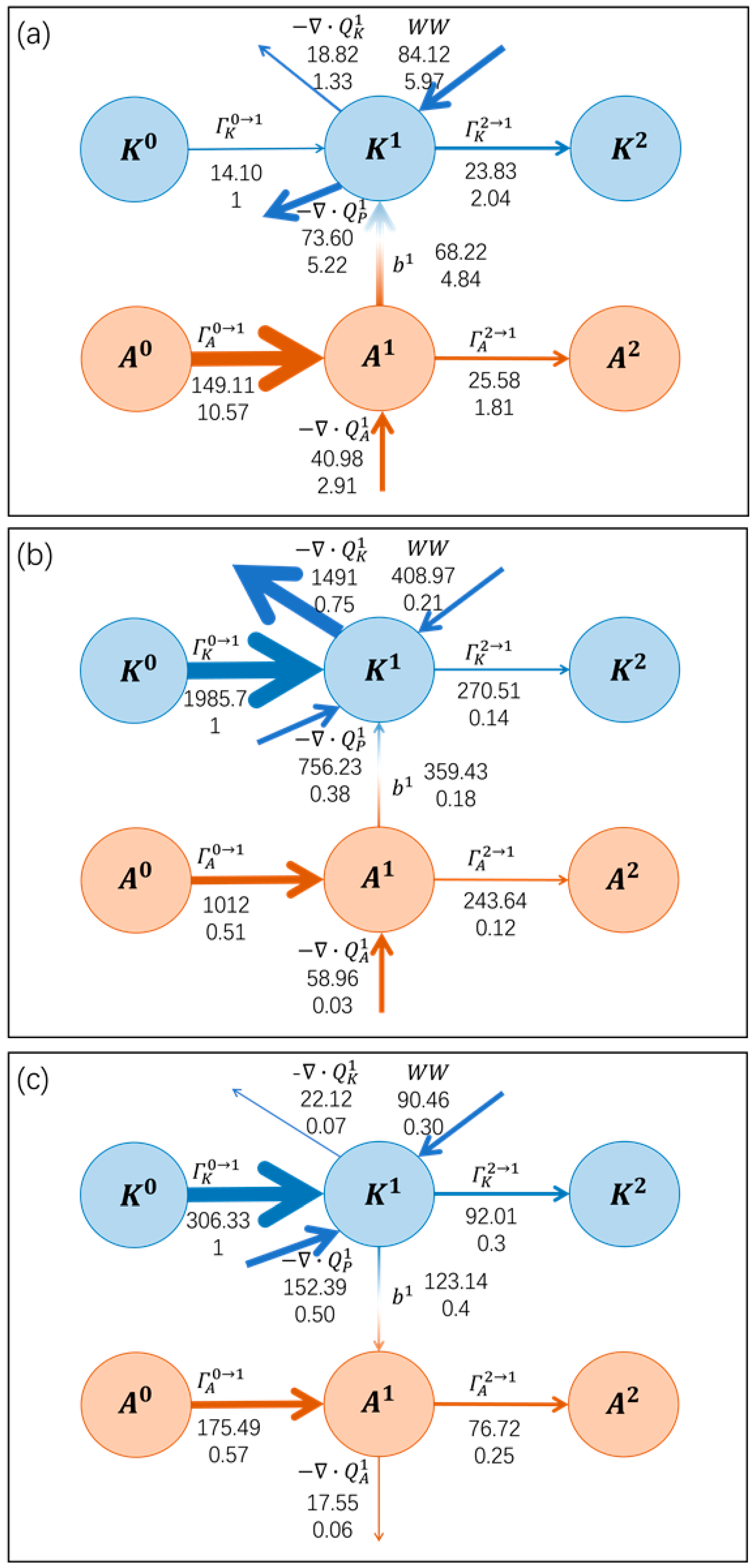
Publisher’s Note: MDPI stays neutral with regard to jurisdictional claims in published maps and institutional affiliations. |
© 2022 by the authors. Licensee MDPI, Basel, Switzerland. This article is an open access article distributed under the terms and conditions of the Creative Commons Attribution (CC BY) license (https://creativecommons.org/licenses/by/4.0/).
Share and Cite
Zhao, Y.; Yang, Y.; Mao, L.; Zhang, Y. On the Genesis of the South China Sea Mesoscale Eddies. J. Mar. Sci. Eng. 2022, 10, 188. https://doi.org/10.3390/jmse10020188
Zhao Y, Yang Y, Mao L, Zhang Y. On the Genesis of the South China Sea Mesoscale Eddies. Journal of Marine Science and Engineering. 2022; 10(2):188. https://doi.org/10.3390/jmse10020188
Chicago/Turabian StyleZhao, Yuhui, Yang Yang, Longjiang Mao, and Yuanzhi Zhang. 2022. "On the Genesis of the South China Sea Mesoscale Eddies" Journal of Marine Science and Engineering 10, no. 2: 188. https://doi.org/10.3390/jmse10020188
APA StyleZhao, Y., Yang, Y., Mao, L., & Zhang, Y. (2022). On the Genesis of the South China Sea Mesoscale Eddies. Journal of Marine Science and Engineering, 10(2), 188. https://doi.org/10.3390/jmse10020188





